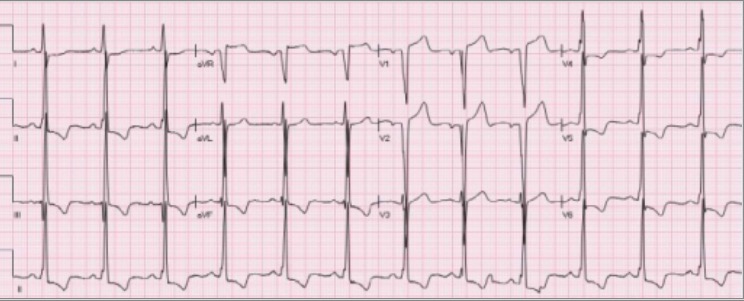Playlist
Show Playlist
Hide Playlist
Definition and Pathogenesis – Hypertensive Heart Disease
-
Slides Valvular Hypertensive Heart Disease.pdf
-
Reference List Pathology.pdf
-
Download Lecture Overview
00:00 Welcome back. We’re going to talk about a significant and important cause of heart disease, which happens quite commonly in the human population due to hypertension. 00:13 And it’s not just high blood pressure necessarily in the systemic circulation, in the arterial circulation, you can also have pulmonary hypertension related to increased pressure in the pulmonary circulation causing right heart failure. So, we’re going to talk about both. Here’s our model of a normal heart. We can see, again, just for orientation, on the left-hand side we have the superior vena cava, inferior vena cava coming into the right atrium crossing the tricuspid valve into the right ventricle and out through the lungs. All of that is indicated in blue. Blood will return through the pulmonary veins, through the mitral valve into the left ventricle and out the aorta. All of that is indicated in pink. Note, the relative thickness of the ventricular walls. Alright, if we have normal pressure such as indicated here, then the heart muscle has a certain thickness to the walls, left ventricle slightly, in fact moderately more thickened than the left ventricle because it has to sustain higher systemic pressures. Average would be 120 systolic over 80 mmHg diastolic. Now, if we have pressure overload, so increased systemic pressures as we talked about in the previous talk, having to do with what causes hypertension. If we have increased systemic pressures, the left ventricle responds by undergoing hypertrophy. I can’t get more heart muscle cells, that’s just not the way it works, these are terminally differentiated cells. So, I have to make each individual cell have more sarcomeres so it can squeeze more effectively. The cells are going to get big. So, there’s going to be cellular hypertrophy. As a result, the left ventricle wall becomes hypertrophic, thickened. Okay, so what does this mean though, down at the cellular and kind of even the molecular level. Well, the individual cells have to get bigger. 02:16 They undergo myocyte hypertrophy. That’s adaptive. Myocyte hypertrophy is adaptive, but only up to a point because there’s an increased diffusion distance now between the capillaries around each cardiac myocyte, and as the cells get bigger and bigger and bigger, that capillary density doesn’t increase. So, there now is going to be a relative diffusion radiant of oxygen and nutrition into the middle of these large hypertrophied myocytes. That means that there is potential for low-grade ischemia and a potential for arrhythmias because we have abnormal ATP generation and, therefore, abnormal movement of various ions. So, it’s not completely perfectly, wonderful adaptive. 03:05 It can, after a period of time, become maladaptive. There’s also, as we stress the heart and make it work harder, we’re going to have increased intracellular organelle or turnover and we’re going to have increased matrix production. So, not only are the cardiac myocytes feeling this increased pressure and the need to squeeze harder, the fibroblast that composed maybe 25% or 30% of the cellularity of the heart are also going to feel this increased pressure. Their response is to make more matrix. Ooopps, that makes the heart stiffer. So, now we’re going to have diastolic dysfunction; the heart won’t relax very well. It may squeeze, okay up to a point, but with that increased fibrosis due to increased matrix production by all those fibroblasts, we’re going to have a stiffer heart. 03:56 As a result of this relatively stiffer heart, we’re going to have regurgitant flow. 04:02 At some point, the valve will not close appropriately, and as we get regurgitant flow into the atrium and then into the pulmonary circulation, we will have atrial fibrillation. 04:13 But, number one cause of atrial fibrillation is left atrial dilation. And as we increase volume and pressure retrograde into the pulmonary circulation, now we’re going to have pulmonary edema, congestive heart failure. So, long-term hypertensive changes in the heart will lead to arrhythmias, pulmonary edema, diastolic dysfunction.
About the Lecture
The lecture Definition and Pathogenesis – Hypertensive Heart Disease by Richard Mitchell, MD, PhD is from the course Valvular and Hypertensive Heart Disease.
Included Quiz Questions
What is a structural change in the heart caused by hypertension?
- Ventricular hypertrophy
- Atrial hypertrophy
- Ventricular hyperplasia
- Atrial hyperplasia
- Thinning of the ventricular walls
What are the characteristics of hypertensive heart disease?
- Increased left ventricular filling pressure, increased left atrial volume, increased pulmonary pressure
- Decreased left ventricular filling pressure, increased left atrial volume, increased pulmonary pressure
- Increased left ventricular filling pressure, decreased left atrial volume, increased pulmonary pressure
- Decreased left ventricular filling pressure, decreased left atrial volume, increased pulmonary pressure
- Increased left ventricular filling pressure, increased left atrial volume, decreased pulmonary pressure
Customer reviews
5,0 of 5 stars
| 5 Stars |
|
5 |
| 4 Stars |
|
0 |
| 3 Stars |
|
0 |
| 2 Stars |
|
0 |
| 1 Star |
|
0 |




